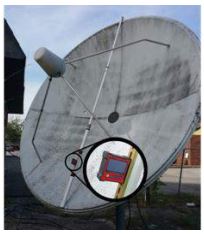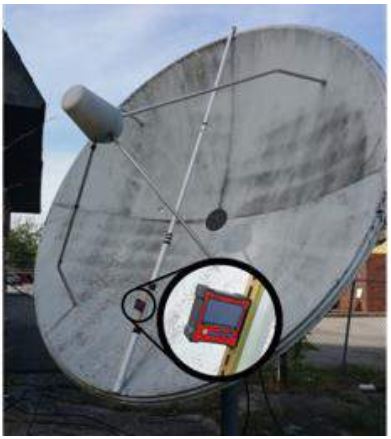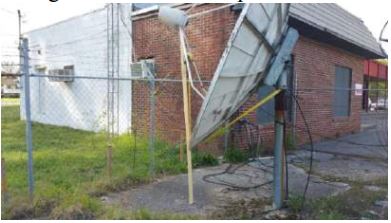Surviving the AMC8-18 Transition

[May 2017] There is major move going on, as AMC8 is retired and stations all over the country are repointing their dishes at AMC-18. If you are looking for information on getting the job done, Kevin Kidd is here to offer help.
In Part I of this article we talked about things that needed to be considered prior to loosening the first jack bolt.
In Part II, we are going to examine some of the parts, materials and equipment that you may need to accomplish the task at hand. I have also included some very, very basic aiming instructions.
Let me reiterate, If you have never aimed a dish before and do not have a backup available, you really should get help from someone familiar with aiming dishes for broadcast radio and other TV services.
FYI: The local TVRO or DSS dish guy may have done a lot of dishes but probably nothing like you are about to do.
Will the Dish Work?
You are probably aware that the new location requires a 2º compliant dish.
First important point: just because a dish is large doesn’t mean that it is 2º compliant. If you have just learned this, avoid wasted time/effort by checking your dish.
How can you know if your dish is 2º compliant?
1. The manufacture’s specifications are the only real way that I know of to be certain.
2. You can tell by size – to some extent, most old dishes less than 10 feet in diameter are either not 2º compliant nor will provide enough gain for these weak carriers.
3. Depending on your location relative to AMC-18, you can swing the properly re-aimed AMC-18 dish back and forth through the satellite arc, East and West of your peaked look angle & polarity to see what you see on the Spectrum Analyzer, viewing the entire LNB L-band output. Count and note the C-band satellites that you see and follow them using the resources at dishpointer.com, lyngsat.com and/or satbeams.com.

After seeing how many adjacent satellites you can see, you can do some mental mathematical/geometrical gymnastics and get an idea of the elevation difference between AMC-18 and the last C-band carriers you observed. Generally, if you do not see any additional carriers that are 2 to 3 degrees above or below your look angle, you are probably good.
4. All this considers your location relative to the satellite location, that the dish is true, the mounting pole is perfectly vertical, the feed is perfectly centered, etc, etc. This pseudo-test is best performed on a local dish that is 100% known to be 2º compliant and then compared to other dishes in the vicinity that are unknown.
5. On the other hand, there are a number of physical caveats of which you need to beware. We will get to “gotchas,” shortly.
Preparing to Move the Dish
Here are some resources you should collect be-fore starting the move:
1. A helper with strong back, or build the dish winch/jack described below. This appliance does not eat as much nor complain as much as the helper will. But the helper will still be required on some dishes.
2. PB Blaster or equivalent.
3. Carrier plots (look for them at: amc8migration.com).
4. Carrier frequency numeric information: (also at amc8migration.com).
5. Receiver manuals and programming information.
6. Receiver IP addresses, if the receivers have no display. The XDS Discovery Tool is a life-saver for *&%$&*#!!! displayless receivers. (It should be an FCC rule that all receivers must have a *&%#$* display. I assume that the iPump receivers have a similar tool but have never used it.)
7. AMC-8 look angle elevation (for surface verification) (information is at: dishpointer.com).
8. AMC-18 look angle elevation, azmuth, and LNB polarity skew (also at dishpointer.com).
9. An accurate protractor. I have been using a digital “Floureon Axis Level Box Inclinometer Dual Axis Digital Angle Protractor with 5 Sides Magnetic Base DXL360S”
10. A Test Receiver (an XDS/iPump/whatever) for signal verification at dish location without having to run in/out, in/out, in/out.
11. 2, 3 or 4-way splitter – with power pass on 1 port only – to temporarily install at dish.
12. RG-6 and F-connectors to build or replace jumpers.
13. Several various length RG-6 jumpers, up to 20 or 30 feet.
14. An 8-foot step ladder or man lift.
15. After finding a couple of dishes with no surface on the dish square or perpendicular to the face angle, I built an extendable fixture to lay across the face of the dish to which the protractor can be magnetically affixed.

16. I already had a cheap 16-foot collapsible aluminum survey range rod (collapses to about 5-feet).
In the top of the range rod, I drilled a suit-able hole for a long eye-bolt to hang over the top edge of the dish and taped a flat smooth, flat piece of sheet metal to the bottom section on which to place the magnetic protractor. I added a small aluminum spacer to the eye-bolt to offset the range rod’s taper but on a large dish that angle error will be negligible without it. A long straight board or pipe would suffice.
The range rod does nothing a simple straight board will not do but is rigid, collapsible and light weight.
17. A Dish Jack/Winch. Big AZ/EL dishes are heavy. I purchased a cheap strap winch at Harbor Freight ($24) and securely screwed it down near the end of a good clear pine 2 x 4 x 8 foot board. This “jack” is placed against the front of the dish with the winch facing the dish near the top of the board.

The strap runs down and under the lower edge of the dish and hooks near the dish mount hinge point. With the winch, I put enough pressure on the dish to be able to easily loosen the elevation hardware and then raise the dish using the winch.

This little bugger saves your back and shoulders not to mention not having to listen to your helper complain about holding that heavy dish while you try to focus your sun-seared eyeballs on the protractor.
18. An F-connector to Type-N (or whatever your Spectrum Analyzer requires) adapter.
Pointing the Dish
If you are using an Azimuth/Elevation mount, here is a list of the basic procedures to properly move and point a dish. As you go, be sure to take pictures, pictures, and more pictures:
1. Document the current EB & AG readings on all receivers.
2. Check for wasp nests in the feed & scalar cover.
3. Mark the old LNB angle.
4. Mark the old Azimuth angle.
5. Mark the old Elevation angle.
6. Set the LNB to the new skew using a protractor before raising dish.
7. Move the Elevation to new numbers.
8. Move the Azimuth to the new neighborhood.
9. Watch the spectrum analyzer for known carrier plots while moving the dish back and forth through azimuths to AMC-18.
10. Maximize signal strength with Azimuth/Elevation adjustments and minimize cross-polarity interference with the LNB skew.
11. Tighten all mounting hardware while monitoring both the spectrum analyzer and receiver readings.
12. Touch up aiming as needed to offset dish movement during tightening. This may have to be done several times.
13. Finally, reboot all the receivers.
If this all went well, you are now on AMC-18, and your programming should be available through your receivers.
Using a Polar Mount
If you are using a Polar mount, here is a list of the basic procedures to properly move and point a dish. But, here is the same advice as before: as you go, be sure to take pictures, pictures, and more pictures:
1. If you are lucky and the original installer set up the polar mount correctly and all hardware is still operable (including the polar jack), your job is pretty easy.
2. As above, document, document, document all receiver readings.
3. Check for wasp nests in the feed & scalar cover.
4. Check for motorized polar adjustment (see above for reasoning).
5. Mark or measure the old position. This can typically be measured along the polar jack or marked on the polar jack if it is operable.
6. The LNB should not have to initially be moved because the polar mount will rotate the feed polarity as it swings across the arc.
7. Watch the Spectrum Analyzer for known carrier plots while moving dish back and forth through the azimuths to AMC-18.
8. Maximize the signal strength with Azimuth/Elevation adjustments, and minimize cross-polarity interference with the LNB skew.
9. Reboot all receivers.
Gotchas
For some reason, it seems ordained that every project has some gotchas. In the case of dish moving and re-aiming, here are a few for you to consider:
1. Carrier Standards Are Not. I re-aimed a large IFC dish that had recently been moved to a new studio complex. The dish was nice and clean with a brand new 15 kHz PLL LNB. It had been working perfectly on AMC-8 for several months. We were really patting ourselves on the back for having it on-bird and peaked for an EB/AG of 15/60+ on a Premiere XDS receiver in a record of about 40 minutes.
However no amount of receiver reprogramming nor dish tweaking would make a pair of WW1 receivers lock. We could see them scanning back and forth between the old and new carrier frequencies with no lock. I finally called WW1 tech support and after confirming that all manner of dish aiming had been done, was told to “offset” the published carrier frequency of 01,121,000 kHz to 01,124 or 01,127 to see what happened.
This time, both receivers instantly locked at 01,124 and began passing audio. To this day we still do not know what the problem is but it cost us about five hours of head scratching and thumb sitting. To complicate matters, I did not obey Rule #1 that says to document, document, document the current receiver readings. One of the jocks thought that there might have been a red light on one of the receivers but did not know which light nor which receiver.
After “offsetting” the carrier frequency, the station’s engineer had noticed that the WW1 receivers have been regularly showing Tuner Unlock and Stream faults. It could be the LNB, it could be the receivers. The Premiere receiver has been 100% reliable since the move. Or it could be that the dish is not really 2º compliant and the WW1 carrier is taking hits from an adjacent satellite.
In the past few weeks we have heard from a number of other engineers reporting that they too had to “offset” the published WW1 XDS frequency by some amount. This seems to be a problem only with WW1 and older serial numbered receivers.
2. Carriers Down. Another engineer reported moving a dish using the carrier plots published for one transponder – and not finding it.
After much consternation and re-re-re-aiming, they found that they were in fact seeing AMC-18 but one of the uplinks was down and the carrier group signature that they had been looking for did not exist at that minute. And the carrier group was one of the biggies.
The lesson from 1 & 2 here is:
a. Do not assume that because it is a satellite service that it is 100% reliable.
b. Do not assume that if you cannot find the blasted thing, it must be your problem.
c. Do not hesitate to check with network TOC’s for problems and solutions. I am hearing reports of extended wait times (as much as a day) for live assistance and return calls.
d. Do have plots of as many of the potential carrier groups as possible available for comparison. For satellite identification purposes, it does not really matter if it is the carrier that you are actually using. The site, amc8migration.com now has plots for at least three carrier groups on three different transponders online.
3. Time. Do not allow yourself to be forced into an unrealistic time frame for aiming a dish. You do not need that stress. Do not be a hero.
4. Incomplete Move. Do not move a dish without 100% confirmation that all services are available at AMC-18. You will probably get to move it back to the old slot.
5. Receivers with the fall-back frequencies programmed will automatically scan back and forth between the old and new frequencies when they lose lock. Be patient.
The swap only happens every four(ish) minutes.
You can tell when the receiver swaps by watching the display. The display will sort of flash and the AG will change by some amount. EB may even come up a few points from the dreaded “– –”… and fall right back to “– –” a second later. If you are on the correct bird (and #1 above is not happening), you should get an EB measurement that is not “– –.”
6. One problem that we run into with the scanning between old and new frequencies is, while peaking the dish, we sometimes lose lock due to any number of things and the receivers will start scanning again. If it scans over to the old frequency, four minutes is plenty of time to really screw up an otherwise good aiming.
7. Reprogramming the receiver frequency from the front panel display does not stop the scanning. We found it did seem to stop when the carrier frequency was changed from the network GUI (accessible by the unit’s local IP address, serial and password). This function is only available from the local LAN and is not available from the various program setup internet sites.
There are “receiver IP finder” apps available from the various providers if you do not know your receivers IP address. XDS Discovery Tool will locate every XDS rx on the local network. I assume that there is a similar tool for Wegner iPump (and others) but have never used it.
8. We have found that seldom do all receivers show maximum EB/AG at the same time. This is probably due to adjacent or cross-polarity interference.
9. Be aware of bad coax’s, splices, splitters, etc.
I was about to re-aim a larger dish with a good LNB and path to AMC-8 but during the document phase noticed the EB/AG’s were very low (EB below 6). Looking at the signal at the back of the dish showed a good signal from AMC-8 but moving into the back of the receiver rack revealed a very marginal signal.
Eventually, I found a wet splice and F-connector in what should have been a waterproof junction box on the outside wall. I replaced the short coax jumper, splice and all receivers popped right back to EB’s of 14-15 with decent AG’s.
10. After moving one dish I noticed a couple of iPump receivers were almost rhythmically going into fault and back out every few seconds. I rebooted both and then they settled down. I now advise that all receivers be rebooted after everything is buttoned up and tightened down.
11. SNOW. Not exactly a problem right now in most places, but. Since the old AMC-8 dishes were standing almost vertical in much of the country, the new dish position is probably going to cause more snow accumulation.
I have been advising folks that they need to have a long-handled plastic shovel ready for every snow event.
On the other hand, down here in Tennessee and Alabama I know that went in one ear and out the other, and I fully expect to have a series of early morning calls after the first overnight snow event here.
12. Some of the dish aiming resources show look azmuths in magnetic, some in “True” and some in both magnetic and true north orientations.
Pay attention to which you are using when you are using a compass to rough aim. In some parts of the country, there are many degrees of Magnetic Deviation between the two. I typically do not use a compass for anything other than path verification prior to the move.
Are You Ready?
Now if all of this has not made you decide to throw in the towel on Broadcast Engineering, you have all of the useful propaganda that I have accumulated based on about a dozen moves to date.
Good luck and may God rest your weary soul.
– – –
Kevin C. Kidd, CSRE/AMD, is the proprietor of AM Ground Systems Company and KK Broadcast Engineering.
You can contact Kevin at: kkidd@kkbc.com or via: www.amgroundsystems.com
